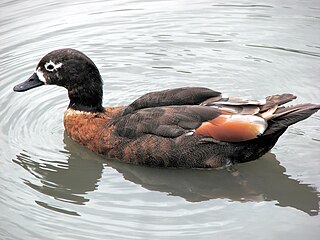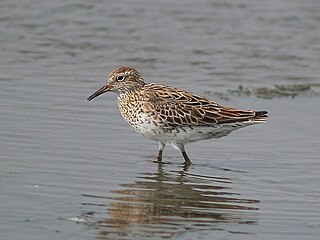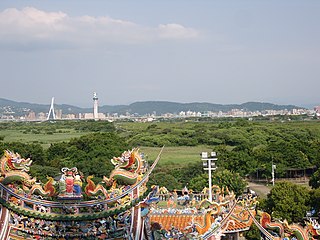
Lake Macquarie or Awaba is Australia's largest coastal salt water lagoon. Located in the Hunter Region of New South Wales, it covers an area of 110 square kilometres (42.5 sq mi) and is connected to the Tasman Sea by a short channel. Most of the residents of the City of Lake Macquarie live near the shores of the lake.

The Tuggerah Lakes, a wetland system of three interconnected coastal lagoons, are located on the Central Coast of New South Wales, Australia and comprise Lake Munmorah, Budgewoi Lake and Tuggerah Lake.

Lake Victoria is a 139-hectare (340-acre) shallow saline lake on the Bellarine Peninsula, Victoria in Australia, close to the township of Point Lonsdale and part of the Lonsdale Lakes Nature Reserve administered by Parks Victoria.

Lake Connewarre, a shallow estuarine 880-hectare (2,200-acre) lake on the Barwon River, is located on the Bellarine Peninsula southeast of Geelong in the Australian state of Victoria.

Tarcutta Hills Reserve is a 432-hectare (1,070-acre) nature reserve on the lower western slopes of the Great Dividing Range in central west New South Wales, Australia. It is 427 kilometres (265 mi) south-west of Sydney, close to the Hume Highway, and 15 kilometres (9.3 mi) south of Tarcutta. It is owned and managed by Bush Heritage Australia (BHA), which purchased it in 1999, and it is listed on the Register of the National Estate.

Lake Warden is a salt lake in the Goldfields-Esperance region of Western Australia. It and its associated wetlands are protected in a nature reserve; they were recognised as being of international importance under the Ramsar Convention through designation of the Lake Warden System on 7 June 1990 as Ramsar Site 485. The lake is also a DIWA-listed wetland.

Lake Gore is a seasonal and semi-permanent freshwater lake in the Goldfields-Esperance region of Western Australia located approximately 24 km (15 mi) west of Esperance. It is an important site for waterbirds.

Murtnaghurt Lagoon, also known as Murtnaghurt Swamp or Lake Murtnaghurt, is a shallow, ephemeral wetland west of the town of Barwon Heads on the southern coast of the Bellarine Peninsula in Victoria, Australia. It comprises two enclosed depressions, elongated west-east and separated by a low ridge. The wetland is about 2 kilometres (1.2 mi) in length, and up to 600 metres (2,000 ft) wide, with 4.5 kilometres (2.8 mi) of shoreline enclosing an area of 81 hectares. It is connected by a narrow 2.7 kilometres (1.7 mi) palaeochannel extending from the lagoon northwards to the main tidal channel of the lower Barwon River.

The Discovery Bay Coastal Park is a linear protected area of coastal land in western Victoria, south-eastern Australia. The 10,460-hectare (25,800-acre) park extends along the coast of Discovery Bay from Cape Nelson north-westwards for 50 kilometres (31 mi) to the border with South Australia. The park was listed on Australia’s now-defunct Register of the National Estate, and lies within the traditional lands of the Gunditjmara people.

The Western District Lakes of Victoria, in the Western District of Victoria, south-eastern Australia, were recognised on 15 December 1982 as wetlands of international importance by listing under the Ramsar Convention, as Ramsar site no.268.

Lake McLarty is a 219-hectare (540-acre) freshwater lake and associated nature reserve on the Swan Coastal Plain of Western Australia. The lake is named after a prominent pioneering family which settled in the district in the early 1860s. It lies about 90 kilometres (56 mi) south of Perth on the eastern side of the Harvey Estuary and forms part of the Peel-Yalgorup System Ramsar site. It is an important area for waders, or shorebirds, and is a well-known birdwatching site.

Lake Newland Conservation Park is a protected area in the Australian state of South Australia located on the west coast of the Eyre Peninsula about 10 kilometres (6.2 mi) north of the town of Elliston. It was proclaimed in 1991 in order to protect Lake Newland, a hypersaline lake, and an associated wetland complex.

The Menindee Lakes is a chain of shallow ephemeral freshwater lakes connected to the Darling River to form a storage system. The lakes lie in the far west region of New South Wales, Australia, near the town of Menindee.

The Yambuk Important Bird Area comprises a 10 km2 tract of coastal land fronting Bass Strait in south-western Victoria, south-eastern Australia. It lies some 20 km west of the town of Port Fairy and encompasses the lower reaches of the Eumeralla River and Lake Yambuk.

Yashilkul is a freshwater lake in Gorno-Badakhshan Autonomous Province, in southeast Tajikistan, about 130 kilometres (81 mi) east of the provincial capital of Khorugh. Lying in the upper Gunt valley of the Pamir Mountains, it has an area of 3,600 hectares with a maximum depth of 52 metres (171 ft). It lies 1.5 kilometres (0.93 mi) from a similar lake, Bulunkul, both of which are surrounded by other wetlands as well as sand and pebble plains. The lake forms part of the Bulunkul and Yashilkul lakes and mountains Important Bird Area.
The Kattasay and Daganasay Reservoirs Important Bird Area comprises two irrigation reservoirs and their surrounds in central Sughd Province in northwestern Tajikistan. Together, they have been identified as a 98 square kilometres (38 sq mi) Important Bird Area (IBA) by BirdLife International.

Little Dip Conservation Park is a protected area in the Australian state of South Australia located in the Limestone Coast about 105 kilometres north-west of Mount Gambier and about 5 kilometres south of the town of Robe. It was proclaimed as a conservation park under the National Parks and Wildlife Act 1972 in 1975 for the purpose of conserving 'remnant vegetation and a chain of small lakes which combine to provide habitat for several endangered and vulnerable bird species' and managing 'the increasing use' of the locality 'for recreation purposes'. The conservation park is classified as an IUCN Category VI protected area.

Lake Hawdon South Conservation Park is a protected area located in the Australian state of South Australia in the locality of Bray about 280 kilometres (170 mi) south-east of the state capital of Adelaide and about 18 kilometres (11 mi) east of the town of Robe.



























